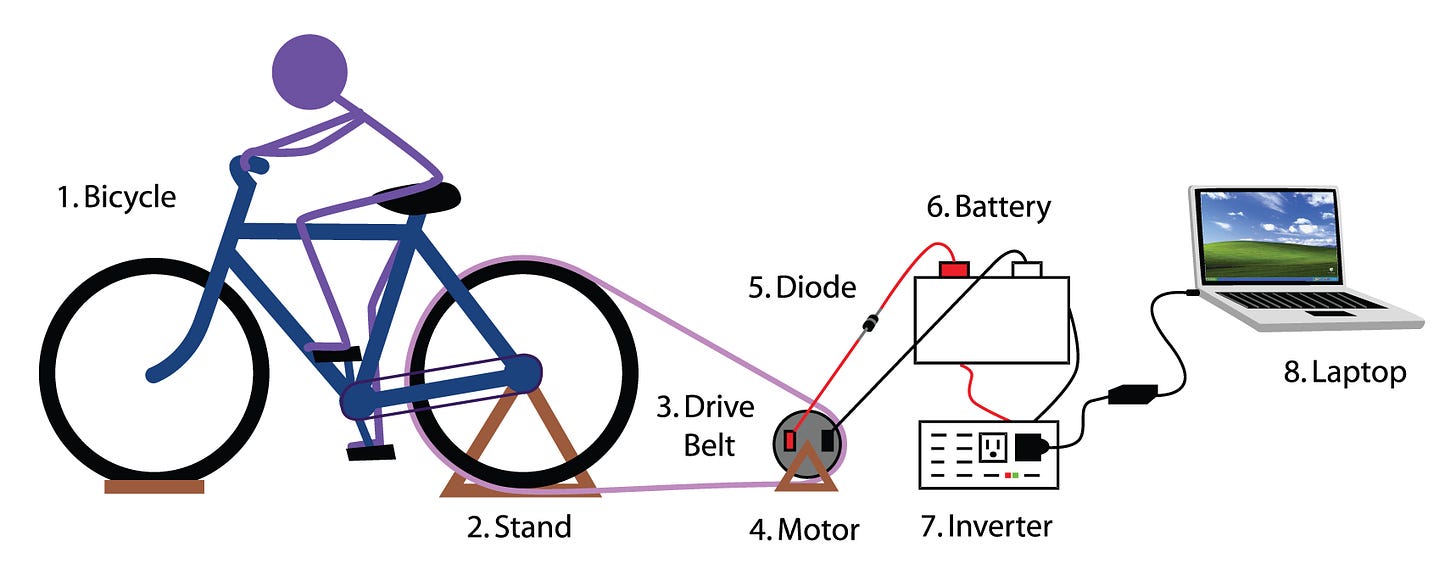We need your support! This Friday we’ll publish a newsletter about the power of interactive coding in Javascript and HTML5, interviewing the developers behind the game Danger Crew. It will go to paid subscribers only. We hope you’ll consider subscribing at $5 / month or $50 / year so we can continue the newsletter.
This week in issue 15 of The Toolkit we’re going to talk about ENERGY. First, we’ll use solar energy and a baking sheet to turn old crayons into new crayons. Second, we’ll ruin your potato salad by turning the potato and pickle into electrical appliances instead. And finally, we’ll look at how people turn bicycles into pedal turbines for their own personal power plants.

Electricity Is in Everything
Our goal today is to look at different parts of the electrical cycle by doing some cool and classic projects. Electricity is arguably the most important part of modern life — it drives everything from household appliances to quantum mechanics and can be made from nuclear power plants or wind.
Solar panels are powered by the same idea we use to melt crayons on a baking sheet. Adding metal terminals to a regular potato turns it into a device that can make power by channeling ions from one side to the other. When we plug in a pickle, it lights up in a special way indicated by sodium instead of the color profiles of other elements. Last but not least, a bicycle generator mimics the real mechanics that store energy in many of the world’s power plants, where kinetic or heat energy is directly translated into turbine-spinning electromagnetic current.

Ages 5-8: Solar Powered Crayons (activity)

Even little kids will love melting crayons in the sun, and August in America is the perfect time. Here are simple instructions from Parents magazine. The secret to metal’s success with conducting heat and electricity is in the atoms: electrons can move around inside these materials, and they easily carry and discharge energy. In this case, metal in the sun absorbs energy from photons in the sun’s rays, which kicks the electrons into action. When we build photovoltaic solar panels, we’re using ideas that best catch and hold photon energy, like an advanced baking sheet. (Pro tip: keep similar color families in your broken crayons to avoid Oops! All Brown.)
Ages 8-12: The Electric Potato Acid Test (activity)

The potato battery is an absolute classic experiment. Here’s one version with full instructions. You can also use a similar setup to make a pickle light. These experiments, especially together, show us a ton of great stuff about how electricity works. First, both potato and pickle have a through-line of liquid, which is a great conductor—each wet vegetable is just swapping out for a length of metal wire and doing a surprisingly good job. Pickles are salty, and sodium conducts well, even in our bodies in the form of electrolytes. And the potato battery uses a zinc nail as one terminal and a copper coin as the other, directing the flow of ions the same way a real battery does.
Ages 12-15: Pedals to the Conductive Metal (activity)

I think the potato battery is great for kids this age too, especially since the science scales up. But if you’re looking for a little bigger project, let your kids help you turn a bike into a generator. Mother Earth News has a great piece about why people want this, and Popular Mechanics has a good walkthrough. It’s a clean way to store backup power, for example, or to combine exercise with a side benefit in an environment like space or remote research stations.
What’s cool about this project is that it closely mimics what real electrical power plants are doing around the world. The pedaler is taking the place of spinning wind turbines, a nuclear reactor, or even burning fossil fuels—generating the “heat” and motion that induce electrical energy using powerful magnets. (Here’s a great explainer of that from the U.S. Energy Information Administration.)
(Last week’s newsletter was: The science of succulents.)

Forward this email to anyone who you think might enjoy it!
Get in touch: Contact us at toolkitnewsletter@gmail.com
Wow that’s cool!
This week, Buzzfeed’s Inga Lam did a video where she only cooked and ate foods spotted in Studio Ghibli movies, including the most giant red bean bun:



